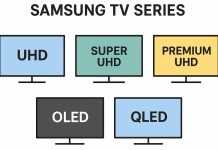What is Wide Color Gamut
Wide Color Gamut technology is not new, this technology was developed in 2005 and is designed to increase the depth and saturation of color, which would allow to bring the colors on the TV screen closer to the natural. Wide Color Gamut allows colors to be reproduced at 97-99% of the capabilities of the TV screen.
Since this technology was invented before HDR, it was used to improve picture quality, but is now obsolete. It is used in inexpensive entry level TVs.
How Wide Color Gamut Works
Note: that this technology only works with images that have poor digital quality, such as videos that have been digitally converted. From video shot on modern digital cameras, it is virtually useless.
How Wide Color Gamut works, a special program is installed in the TV software that analyzes the color gamut of the image, comparing it to a standard such as sRGB. It tries to improve the image by increasing contrast, saturation and gamut.
The monitor is involved in this process, since you cannot reproduce a quality image on a bad monitor, and the software that adjusts the image is also involved. The photo below shows an image obtained using Wide Color Gamut technology.
As you can see the image gets brighter and more vivid colors. The original frame had low levels of color tones and low image brightness. What we did was to increase the brightness and color levels. The grass is greener and the auto is redder.
Studies do confirm a significant improvement in the depth and color tones of the image. The image acquires natural, vibrant colors.
LG OLED Wide Color Gamut.
With the advent of OLED televisions, this setting is now available in OLED televisions. This setting tweaks the color of the picture. It is recommended to set this setting to auto. It does not work with HDR content because the setting is useless in that case.
P3 Wide Color Gamut
This name implies that the technology works with the standard DCI-P3 or DCI/P3 , a color space commonly used in digital cinemas. It covers most of the natural spectrum with the most distinctive lack of color in the green-blue part of the range. The technology improves the color gamut by correcting deficiencies in the DCI-P3 range.







Working in the service menu is always a risk. I don’t know if it can break your TV or not.
Hi Anatoliy,
Thank you for these great explanations on this Topic !!!!
Somewhere in the hidden menu of my Samsung budget FHD smart TV 43T5300 (non 4K) I have the option to change color gamut from 0 to 1 or 2. I didn’t try it yet because I’m afraid of breaking my TV after leaving the hidden menu if I change it to 1 or 2.
Do you think it is the option described by you ? If yes, it would be great, because it would improve my SDR content (especially old movies/series found on SDR & FHD TV channels which I watch through my external satellite box with my HDMI cable, ——> and yes some of them are really dark (lack of brightness) like you described it).
Do you think I can give a try without any risk ?
Thanks in advance.
Alexander